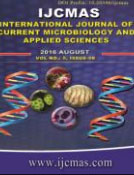


 National Academy of Agricultural Sciences (NAAS)
National Academy of Agricultural Sciences (NAAS)

|
PRINT ISSN : 2319-7692
Online ISSN : 2319-7706 Issues : 12 per year Publisher : Excellent Publishers Email : editorijcmas@gmail.com / submit@ijcmas.com Editor-in-chief: Dr.M.Prakash Index Copernicus ICV 2018: 95.39 NAAS RATING 2020: 5.38 |
Biological crusts collected from seven historical monuments in and around Varanasi, India, were screened for the presence of photoprotective mycosporine-like amino acids (MAAs). Nine strains of cyanobacterial genera such as Lyngbya sp., Nostoc sp., Anabaena sp., Scytonema sp., Phormidium sp., Westiellopsis sp., Aphanocapsa sp., Hapalosiphon sp. and Aphanothece sp. were found to be present in the samples collected from various monuments apart from other group of organisms. Cyanobacteria, the dominant population growing on all the monuments had a maximum diversity of 5 species in Brahaspati temple, 4 species in Ramnagar fort and LalKhan`s tomb, 3 species in Manikarnika ghat and Sanskrit University and only 1 species in Sarnath and Bharat Mata temple. Pigment proï¬le of the crusts from the seven monuments showed peaks at 665, 470, 310 and 386 nm that correspond to the presence of chlorophyll a, carotenoids, MAAs and scytonemin respectively. High content of cholorophyll a was recorded in the crusts from Sarnath and the Brahaspati temple, whereas carotenoids content was higher in the crust sample of LalKhan`s tomb. In all the collected samples from various monuments, photoprotective MAAs were found to be predominant than the photosynthetic pigments (chlorophyll a and carotenoids).
 |
 |
 |
 |
 |